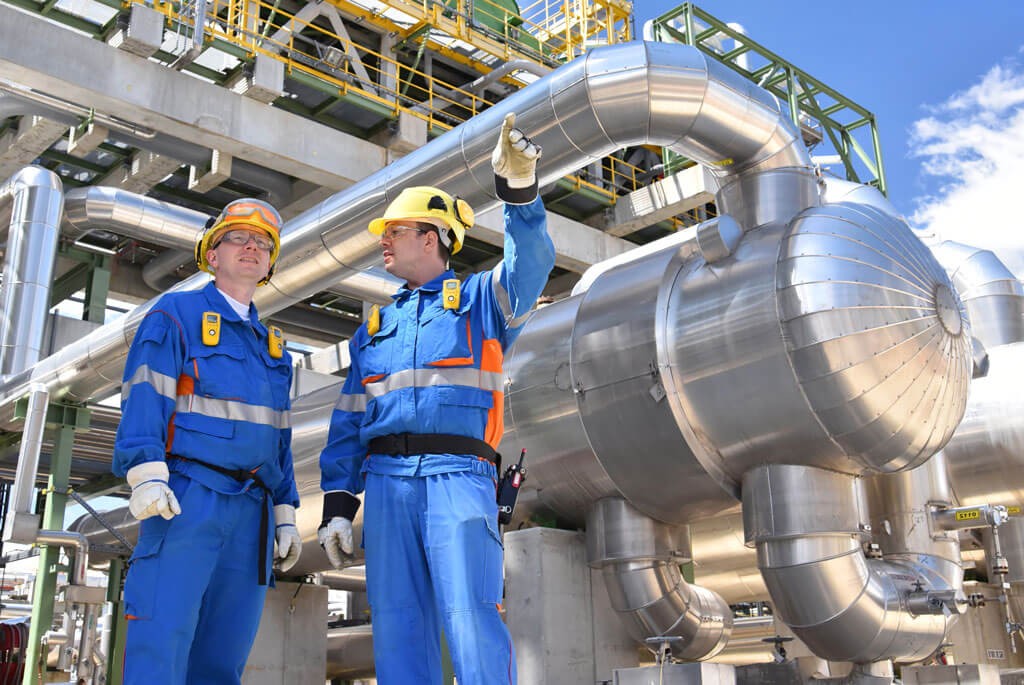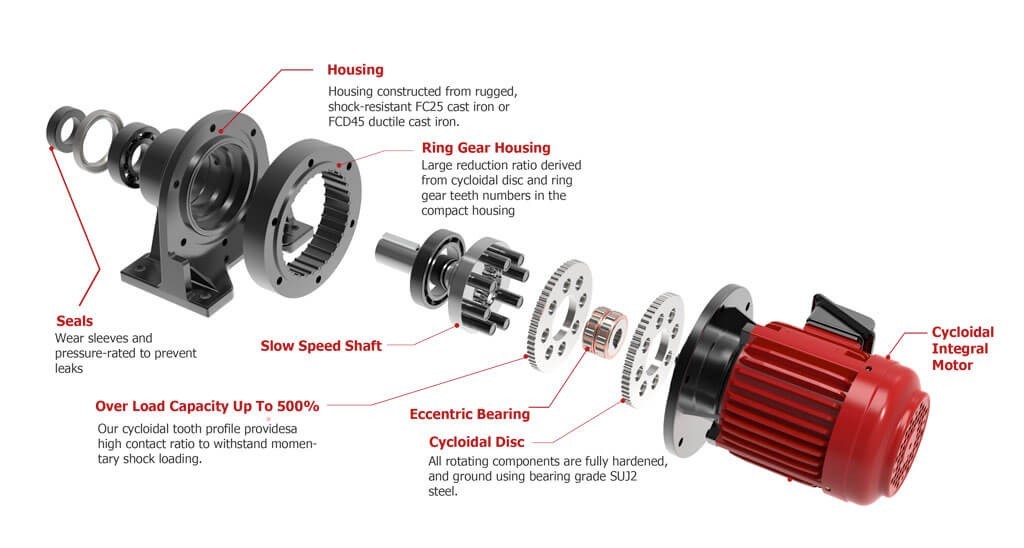Cyclo Drives For Oil Industry Applications
The oil industry prefer cyclo drives for their reliability, durability and chemical resistance
Durable & Resistant Cyclo Drives In The Oil Industry
In the often challenging environment of the oil industry, cyclo drives offer a durable, chemically resistant solution for a wide range of transportation and processing demands. Oil well pumping, rotary kilns, chillers and paraffin filter presses are among the essential oil industry tasks routinely entrusted to cyclo drives because of their dependability.
The extreme durability of cyclo drives comes from the sharing of internal loads. It is very unusual for a cyclo drive to fail without advance warning that maintenance is required. In the time and pressure sensitive oil industry, this makes cyclo drives preferable to conventional gearboxes that can suffer catastrophic failure under peak or unexpected load conditions.
Cyclo Drives: Unmatched 24-7 Operational Reliability
The range of applications of cyclo drives is impressive, as well as specialized roles in oil pumping and other heavy oil industry equipment, cyclo drives are invaluable for general site transport use, cooling fans and mixing.
Cyclo drives offer 24-7 reliability with predictable maintenance intervals and extreme resistance to heavy and shock loadings. Cyclo drives offer a true ‘workhorse’ solution that is unmatched by other gearbox, drive and reducer options on the market today.
Chemical Resistant Cyclo Drives Are Essential In The Oil Industry
In the oil industry, machinery is often exposed to hostile environments. The volatile nature of oil and oil products is a primary concern, as well as the often caustic and corrosive chemical processes used in the oil industry.
Cyclo drives are easily sealed against contamination and chemical damage. This is an additional desirable feature compared to planetary drives, which are harder to protect. The chemicals used in oil manufacturing and processing can cause premature failure of planetary gearboxes and other components.
Applications Of Cyclo Drives In The Oil Industry
Cyclo drives can be used as the first choice, or as a trouble-free alternative to conventional gearboxes, drives and reducers in primary oil pumping roles, as well as being the most reliable option for mixing and transport.
- Oil Pumping
- Chillers
- Conveyors
- Constant Density Mixers
- Variable Density Mixers
- Rotary Kilns
- Escalators
- Cranes & Hoists
- Cooling Tower Fans
- Paraffin Filter Presses
- Screens
- Winde
Cyclo Drives Feature Shock Resistance & High Load Ratings
Oil industry machinery has to perform reliably in any circumstances. Cylo drives resist high shock loadings and have higher load ratings than conventional drives of similar size. Cyclo drives are the perfect choice for extreme reliability where failure is not an option,
Efficiency Gains From Cyclo Drives In Oil Industry Applications
Cyclo drives are more efficient than conventional planetary gearboxes. The main efficiency gains from using cyclo drives in the oil industry come from being able to use smaller drives, standardization of drives because of their flexibility, and easy interchangeability of parts.
A smaller size of cyclo drive can be used to achieve the same performance rating as a larger conventional gearbox. Standard cyclo drives can be used for a wide range of machinery, allowing for standardization. This offers the added benefits of uniform maintenance and a smaller parts inventory.
Selecting A Cyclo Drive For Oil Industry Use
How do I select a cyclo gearmotor?
The selection of a suitable cyclo gearmotor depends on motor horsepower and/or torque requirements measured at the output shaft. Cyclo gearmotors are very efficient over a wide range of reduction ratios. This often means that input power can be reduced, requiring a motor with a lower HP rating, without losing output shaft torque.
What information do I need to select a cyclo drive?
To identify the correct cyclo drive for your requirements, you will need to consider:
- The application: what type of machine is being driven
- Expected daily hours of operation
- Motor horsepower (HP) and speed (RPM)
- Mounting type: vertical, horizontal, right-angle…
Also make a note of any specialized requirements including environmental exposure as this will be useful in determining specific casing and construction details.
How are Service Classes used for cyclo gearmotors & drives?
AGMA-defined Service Classes are applied to rate cyclo gearmotors for defined operational loading conditions. AGMA Service Classifications for gearmotors are: uniform (I), moderate shock (II), and heavy shock (III). These classifications enable you to fit your product selection to specific tasks.
In the oil industry, most applications are AGMA Service Class II, with moderate shock loadings, General purpose site pumping and transport applications may fall into AGMA Service Class I.
Will a cyclo gearmotor withstand unexpected shock loads?
The design features of cyclo gearmotors and cyclo drives make them more shock resistant than planetary gearmotors. This is because loads are spread evenly between moving parts. Cyclo drives and gearmotors can withstand momentary intermittent shocks of 500% of the standard rating.
Planetary gearmotors are normally rated to a maximum 300% momentary shock overload. Our technical team will be happy to design a custom configuration if you expect shock loads greater than 500% of the rating.
What are the standard input speeds for cyclo gearmotors?
Standard cyclo motor speeds at 60Hz are 1750 and 1165 RPM, which equates to 1450 and 980 RPM at 50Hz. Non-standard input speeds will need to be calculated to determine how they affect horsepower and torque ratings. Our technical team are always happy to discuss any requirement.
What are the thermal capacity limitations of cyclo drives?
The smooth, almost frictionless operation (unlike traditional helical gears) of cyclo drives gives them a thermal rating that is beyond the mechanical capacity of the cyclo drive. Cyclo drives are not subject to conventional heat limitations even when worked hard because of the shared internal loadings within the drive.
What inverter turn-down ratio is available?
A 10:1 ratio is standard for unbraked motors. Braked motors may be limited to 4:1 or better depending on power rating. A 1000:1 ratio is available in a C-face configuration.
Key Features of Transcyko 600 Series Cyclo Drives
- Wear sleeves and pressure rated seals ensure excellent sealing of the cycloidal drive even in harsh conditions.
- Casings constructed of rugged, shock-resistant FC25 cast iron or FCD45 ductile cast iron.
- Reduction gearing is contained in a compact ring gear housing for high power density enabling large reduction ratios.
- Fail-safe service as stresses are shared across 60% of component parts during operation, compared to 5% or less for conventional drives.
- Rotating components are vacuum degassed, hardened bearing grade SUJ2 steel for consistent and reliable performance.
- Output shafts can be customized to any size or material requirement.
- Overload capacity withstands momentary shock loads of up to 500% of normal operational range.


